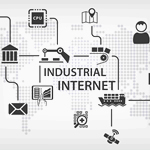
Industrial Internet of Things
Used in manufacturing now for 15+ years, Internet of Things (IoT) devices monitor equipment, automate processes, and improve worker safety. Moore’s Law, a computing term around since 1970 which submits that processor speeds (overall processing power for computers) doubles every two years, applies to IoT devices, too. Their use increases over time, but what happens to all of the data they collect?
For frame of reference, global technology media group TechTarget defines IoT as a system of interrelated computing devices, mechanical and digital machines, objects, animals or people that are provided with unique identifiers (UID) and the ability to transfer data over a network without requiring human-to-human or human-to-computer interaction. A UID is a numeric or alphanumeric string associated with a single entity in a given system, making it possible to address that entity, as well as access and interact with it. They have an entire practice devoted to IoT technology and strategy as it relates to enterprise IT.
A thing, in the Internet of Things, can be a person with a heart monitor implant, a farm animal with a biochip transponder, an automobile that has built-in sensors to alert the driver when tire pressure is low — or any other natural or man-made object that can be assigned an IP address and provided with the ability to transfer data over a network.
CIO Insights: Manufacturing
I attended the Pittsburgh Technology Council recent event featuring chief information officers. While asked to share how they define success, current initiatives underway and what keeps them up at night, collecting and analyzing IoT data was definitely on their minds. All agreed that mining this data for trends can be used to improve quality and subsequently reduce costs.
CIO panelists
- Mark Husnick, CIO, Arconic
- Arconic technology centers transform ideas and innovations into commercial success by engineering products and solutions using advanced materials and technologies, changing the way we fly, drive, build and power.
- David DiLeo, CIO, Industrial Scientific Corporation
- Industrial Scientific, headquartered in Pittsburgh, Pa., is preserving human life through gas detection innovations above and below the earth.
- Richard Smith, VP & CIO, Wabtec Corporation
- Wabtec is leading supplier of value-added, technology-based products and services for freight rail, passenger transit and select industrial markets worldwide, manufacturing a broad range of products for end markets such as locomotives, freight cars, passenger transit vehicles and power generation equipment, for both original equipment and aftermarket applications.
Some key takeaways from the discussion
Cloud computing is vital to the collection of IoT data. Devices transmit data wirelessly to enterprise systems that prepare the information for analysis. Industrial Scientific Corporation depends on IoT devices to support their just-in-time instrument repair service. Over 250,000 distributed devices monitor and transmit information used to identify repair needs. Analysis of this information leads to improvements to products and services.
Did you ever wonder what happened to the caboose? The one time classic ‘last car on the train’ that communicated with the engine, is now an IoT device. Wabtec Corporation uses IoT devices to improve freight line safety.
Low margins associated with large scale manufacturing can be improved through automation and the use of IoT devices. Reductions in the cycle time of production can greatly impact the bottom line. Arconic has realized 20% reduction in manufacturing costs by automating production.
Automation, safety, and quality are examples of how Internet of Things (IoT) devices benefit manufacturing. Analyzing the data to discover trends will lead to ongoing improvements.
Hot Topic: IoT
With the number of connected devices set to top 11 billion in 2018 (that's NOT including computers and phones), IoT is clearly a hot topic.
Forbes reported on IBM's Top 4 IoT predictions
- AI will make IoT smarter and more productive to work with
- More CPU power will be spent at the edge (front-facing elements of IoT such as cameras and sensors which traditionally passively collect data to be processed in the cloud)
- Blockchain adds immutability and integrity to IoT transactions (a distributed and encrypted digital ledger – well suited for recording details of the millions of transactions which take place between IoT machines)
- Massive growth of IoT in manufacturing and industries
Speaking of IoT in manufacturing, xTuple’s lead IoT developer, David Beauchamp, will be demonstrating — and on the agenda speaking about — its practical applications at the annual FABTECH Expo (North America's Largest Metal Forming, Fabricating, Welding and Finishing event) this November in Atlanta, proving that Industrial IoT technology is only limited by your imagination. Check out the agenda!
Let the data collection and analysis begin! I'll close with this quote from Wally Tonra, xTuple's vice president of sales, who's on the frontline of the explosion of IoT needs with our customers to outthink, outsmart and outperform:

